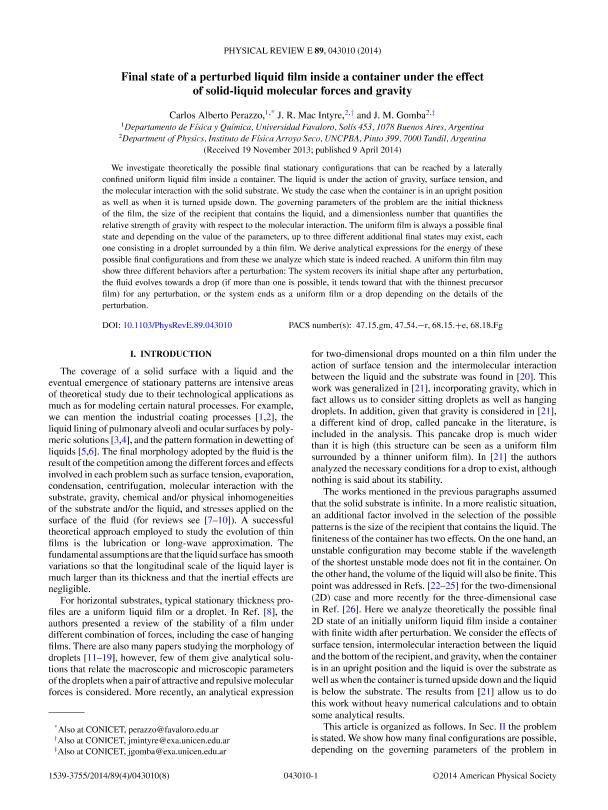Mostrar el registro sencillo del ítem
dc.contributor.author
Perazzo, Carlos Alberto

dc.contributor.author
Mac Intyre, Jonatan Raúl

dc.contributor.author
Gomba, Juan Manuel

dc.date.available
2016-04-18T21:10:52Z
dc.date.issued
2014-04
dc.identifier.citation
Perazzo, Carlos Alberto; Mac Intyre, Jonatan Raúl; Gomba, Juan Manuel; Final state of a perturbed liquid film inside a container under the effect of solid-liquid molecular forces and gravity; American Physical Society; Physical Review E: Statistical, Nonlinear And Soft Matter Physics; 89; 4; 4-2014; 43010-43010
dc.identifier.issn
1539-3755
dc.identifier.uri
http://hdl.handle.net/11336/5280
dc.description.abstract
We investigate theoretically the possible final stationary configurations that can be reached by a laterally confined uniform liquid film inside a container. The liquid is under the action of gravity, surface tension, and the molecular interaction with the solid substrate. We study the case when the container is in an upright position as well as when it is turned upside down. The governing parameters of the problem are the initial thickness of the film, the size of the recipient that contains the liquid, and a dimensionless number that quantifies the relative strength of gravity with respect to the molecular interaction. The uniform film is always a possible final state and depending on the value of the parameters, up to three different additional final states may exist, each one consisting in a droplet surrounded by a thin film. We derive analytical expressions for the energy of these possible final configurations and from these we analyze which state is indeed reached. A uniform thin film may show three different behaviors after a perturbation: The system recovers its initial shape after any perturbation, the fluid evolves towards a drop (if more than one is possible, it tends toward that with the thinnest precursor film) for any perturbation, or the system ends as a uniform film or a drop depending on the details of the perturbation.
dc.format
application/pdf
dc.language.iso
eng
dc.publisher
American Physical Society

dc.rights
info:eu-repo/semantics/openAccess
dc.rights.uri
https://creativecommons.org/licenses/by-nc-sa/2.5/ar/
dc.subject
Disjoining-Conjoining Pressure
dc.subject
Confined Film
dc.subject.classification
Física de los Fluidos y Plasma

dc.subject.classification
Ciencias Físicas

dc.subject.classification
CIENCIAS NATURALES Y EXACTAS

dc.title
Final state of a perturbed liquid film inside a container under the effect of solid-liquid molecular forces and gravity
dc.type
info:eu-repo/semantics/article
dc.type
info:ar-repo/semantics/artículo
dc.type
info:eu-repo/semantics/publishedVersion
dc.date.updated
2016-05-06 15:52:43.262787-03
dc.journal.volume
89
dc.journal.number
4
dc.journal.pagination
43010-43010
dc.journal.pais
Estados Unidos

dc.journal.ciudad
New York
dc.description.fil
Fil: Perazzo, Carlos Alberto. Universidad Favaloro. Facultad de Ingenieria y Cs.exactas y Naturales. Departamento de Fisica y Quimica; Argentina
dc.description.fil
Fil: Mac Intyre, Jonatan Raúl. Universidad Nacional del Centro de la Provincia de Buenos Aires. Facultad de Ciencias Exactas. Instituto de Fisica Arroyo Seco; Argentina. Consejo Nacional de Investigaciones Científicas y Técnicas. Centro Científico Tecnológico Tandil; Argentina
dc.description.fil
Fil: Gomba, Juan Manuel. Universidad Nacional del Centro de la Provincia de Buenos Aires. Facultad de Ciencias Exactas. Instituto de Fisica Arroyo Seco; Argentina. Consejo Nacional de Investigaciones Científicas y Técnicas. Centro Científico Tecnológico Tandil; Argentina
dc.journal.title
Physical Review E: Statistical, Nonlinear And Soft Matter Physics

dc.relation.alternativeid
info:eu-repo/semantics/altIdentifier/url/http://journals.aps.org/pre/abstract/10.1103/PhysRevE.89.043010
dc.relation.alternativeid
info:eu-repo/semantics/altIdentifier/doi/10.1103/PhysRevE.89.043010
dc.relation.alternativeid
info:eu-repo/semantics/altIdentifier/doi/http://dx.doi.org/10.1103/PhysRevE.89.043010
Archivos asociados
